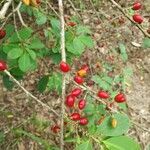Small tree or shrub up to 2.5 m. Lenticels on the branches sometimes warty, very prominent. Leaves chiefly at the ends of the twigs, soon falling, broad-elliptic, c. 3-8 by 2-4 cm, dark green above, paler and glaucous beneath, acuminate or rounded with a mucronate tip, cuneate at the base; midrib prominent beneath; nerves numerous, very faint on both sides, venation delicately anastomosing, two lines giving a clearly distinguishable, slightly concave areolation of a paler colour; petiole c. 2-6 mm. Stipules triangular, more or less bicari-nate, shorter than or as long as the petiole, c. 3-5 by 3-5 mm, persistent, on old branches brown and stiff, top acute, 2-toothed. Ramenta numerous. Flowers in clusters of 6-12, rarely more, in the axil of leaves or ramenta. Bracteoles deltoid small and scarious. Pedicels thickened, c. 4-6 mm. Calyx green, the tube 2-1 mm, lobes triangular-ovate, acute, c. 1-2 mm. Petals yellow or yellowish green, oblong, convex, c. 4-4.5 by 2 mm; ligule 3-lobed (2 lobes crisped), half as long as the blade, claw broad, c. 1/5 of the petal. Brachystylous flowers. Staminal tube c. 1.5 mm. Stamens equal; filaments 4 mm, anthers 0.5 by 0.5 mm. Ovary ellipsoid, slightly longer than the staminal tube, c.2 by 1.5 mm; styles free, c. 2 mm. Dolichostylous flowers. Stamens unequal; episepalous filaments 2 mm, epipetalous ones 3 mm; anthers 0.75 by 0.5 and 0.5 by 0.25 mm respectively. Styles free, 4 mm. Drupe red, oblong-ovoid, pointed, when dry obtusely trigonous, furrowed, c. 7-10 by 3-4.5 mm; sterile cells not very distinct, fertile cell large, almost triquetrous in section. Seed with 3 distinct ribs; endosperm abundant; embryo central, small, c. 6 by 1.5 mm, flattened, cotyledons lanceolate c. 4 mm; radicle c. 2 mm.
More
An erect evergreen shrub. It grows 3.5 m tall. It spreads about 1.5 m wide. The trunk is slender and branching. The leaves are oval but taper to a short tip. They are bright green and 6 cm long. The flowers have five petals and are yellowish-white. They are 6 mm across and are carried in the axils of the leaves. The fruit is soft and fleshy and 8 mm long. They are red berries.


